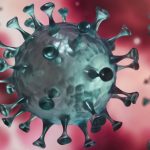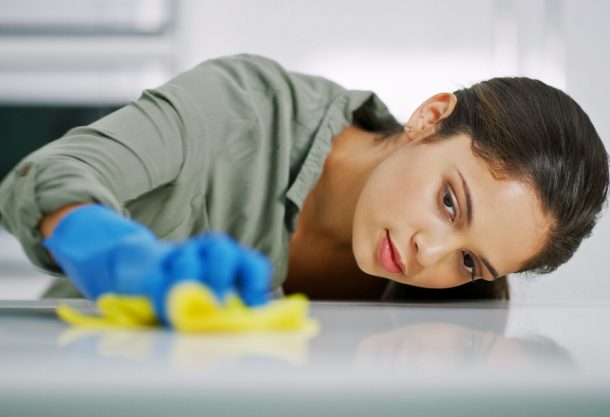Posted on March 19, 2020 in Cleaning

These coronavirus cleaning guidelines are designed to help reduce the risk of spread of the novel coronavirus (COVID-19) from contact with contaminated surfaces.
We recommend people adopt enhanced cleaning processes during this coronavirus outbreak, as it is recognised that good housekeeping procedures will help reduce the risk of coronavirus transmission.
- Property managers should discuss these guidelines with their cleaning contractors and company employees (as applicable) and ensure that they are immediately implemented.
- It is also recommended that property managers periodically observe the actual cleaning process to ensure proper implementation.
- Of primary concern for cleaning and disinfection, property managers need to be aware of the occupancies and surfaces where frequent human contact might provide a reservoir for COVID-19. While each facility and operation will be different, the following areas should receive focused attention:
- Areas of human congregation (including, but not limited to reception areas, communal hallways, communal lounges, offices etc.)
- Hygiene facilities (including, but not limited to, lavatories/toilets, shower rooms, hand- washing stations)
- Dispensaries (including, but not limited to, medical and first aid stations, emergency shower and eyewash stations)
Page Contents
Frequently touched surfaces for coronavirus cleaning:
- Doorknobs and door handles
- Light switches and dimmer switches
- Staircase handrails
- Computer monitors, keyboards, mice
- Desktops and all work surfaces
- Tablets and laptops
- Telephone equipment
- All chair rests and arms
- Canteen tables and chairs, crockery, trays and cutlery
- Sinks, taps and kitchen areas
- Toilets, including all surfaces
- Water fountains and drinks dispensers and vending machines
- Lifts and their doors and buttons.
Coronavirus cleaning frequency
The areas highlighted above should be cleaned at least daily and you should use a commercial disinfecting wipe, detergent with water, or commercial anti-microbial products.
The general guideline is that the more people who contact surfaces, the more frequently that surface should be cleaned.
- Cleaning staff should be responsible for regular cleaning of common areas frequented by employees or residents.
- Provide disposable wipes or other cleaning products so that commonly used surfaces can be wiped down by employees before each use.
Personal protective equipment recommendations:
- Safety glasses with side shields and gloves (non-latex)
- Dispose of gloves after cleaning and wash hand with soap and water for at least 20 seconds
Disinfectants
For general precautionary cleaning, detergent and water are adequate. Many general household products contain the appropriate concentrations of active ingredients (AIs) for disinfection of areas that are very likely to be contaminated with COVID-19 virus.
In addition to the use of cleaning agents, other treatments effective against known coronaviruses include steam and heat treatment. As the COVID-19 virus is new, no study has been published on the virus. This assessment is thus based on published scientific studies on coronaviruses, a group to which the COVID-19 virus belongs.
Guidelines for disinfection for known or suspected cases of COVID-19
These following guidelines are designed for the disinfection of areas that have been frequented by an individual with a known or suspected case of COVID-19. These guidelines are separate from the enhanced routine cleaning guidelines outlined above and will not be used by sites unless they have a known or suspected case of COVID-19.
As part of your preparedness efforts, all property managers should immediately contact their cleaning services provider to confirm whether they have the capability to clean according to these guidelines. Confirming this information now will help you ensure that proper disinfection can begin as soon as possible should any of your sites experience suspected or confirmed case of COVID-19.
In the absence of specific guidance from the World Health Organisation, cleaning contractors should be prepared to follow the European Union guidance contained in the Interim guidance for environmental cleaning in non-healthcare facilities exposed to SARS-CoV-2 (February 18, 2020) until further notice.
The survival time for COVID-19 is not known for certain, so it is best to assume that the virus can survive on surfaces of different materials for at least 2 to 3 days, and possibly longer. Where there is reason to suspect that surfaces may have been contaminated with COVID-19, the surfaces should be sanitised. If the potentially contaminated surface is covered with a textile, it may be necessary to launder the material at the warmest temperatures recommended for the material with a laundry detergent and bleach.
Disinfectants should be prepared and applied in accordance with the manufacturer’s recommendations. Ensure that appropriate contact time is given before rinsing or removing the disinfectant. Please see the Disinfectants section below or refer to the European guidance referenced below for recommendations on disinfectants that can be used.
Important points to note when using disinfectants:
- Check the labels and use according to instructions, and be aware of the potential hazard of each product
- Avoid contact with eye and skin when handling cleaning products
- Comply with all warnings and precautions for use
- Do not mix different cleaning products
- Use in a well-ventilated area
For disinfection of highly contaminated surfaces or material, avoid the use of spray, and allow appropriate contact time needed for disinfection prior to rinsing or removing the product from the treated surface (refer to product instruction)
Specific work instructions with respect to disinfection (in addition to the European guidance)
- Cleaning staff should wear disposable gloves, disposable long-sleeved gowns, eye goggles or a face shield, and a disposable respirator or equivalent during the cleaning
- Gloves should be removed and discarded if they become soiled or damaged, and a new pair worn
- Disinfection can be limited to specific locations within the facility where the infected person spent time or was likely to have contacted surfaces (i.e., not just passing through such as an entrance vestibule)
- Active ingredients and their effective concentrations listed below have been shown to be effective against known coronaviruses. In addition to the use of cleaning agents, other treatments effective against known coronavirus include steam and heat treatment. All disinfectants should be used according to the manufacturer’s instructions.
- Soak cloths, mops, etc. with disinfectant or bleach solution and avoid spray applications which may create splashes and further spread the virus
Wipe table tops, desks, benches or other horizontal surfaces with human contact with disinfectant or the prepared bleach solution at the beginning and again at the end of the cleaning - Where possible, seal off areas where the confirmed case has visited until all cleaning and disinfection of the contaminated surfaces has been completed
- Remove curtains, fabrics, quilts, pillows and cushions for washing, preferably using the hot water cycle. Alternatively, you may choose to simply dispose of these items.
- For hot-water laundry cycles, wash with detergent or disinfectant in water at 70ºC for at least 25 minutes. If low-temperature (i.e., less than 70ºC) laundry cycles are used, choose a chemical that is suitable for low-temperature washing when used at the proper concentration.
- Arrange for a cleaning contractor to properly disinfect any carpets that have been used by any person who has been confirmed to have COVID-19
Floors and hard surfaces should be cleaned using a disinfectant selected from the list below or contained in the European guidance - Disinfect non-porous cleaning equipment by soaking in disinfectant or bleach solution. Disinfect equipment used in one room, before using for other rooms. If possible, keep the disinfecting equipment separated from other routine equipment.
- Double-bag all materials for disposal (including rags, respirators, disposable gowns and gloves) and seal with a cable tie. Wear a new pair of gloves for handling the bag.
- Waste should be disposed of upon completion of the disinfection work in accordance with local or country regulations for the disposal of biohazardous waste.
Disinfectants for coronavirus cleaning
Many general household products contain the appropriate concentrations of active ingredients for disinfection of areas that are likely to be contaminated with COVID-19.
In addition to the use of cleaning agents, other treatments effective against known coronaviruses include steam and heat treatment.
For more information or assistance please call 0845 604 1288 and speak with one of our friendly team or visit Specialist Disinfection Cleaning Services.
Categories
- Building Maintenance
- Cleaning
- Electrical
- Gardening
- General Info
- Our Service
- Pest
- Security
- Uncategorized
- Waste Solutions
Archive
- April 2024
- March 2024
- February 2024
- January 2024
- December 2023
- November 2023
- August 2023
- April 2023
- February 2023
- January 2023
- December 2022
- November 2022
- October 2022
- September 2022
- August 2022
- July 2022
- June 2022
- May 2022
- April 2022
- March 2022
- February 2022
- January 2022
- December 2021
- October 2021
- September 2021
- August 2021
- July 2021
- June 2021
- May 2021
- April 2021
- March 2021
- February 2021
- January 2021
- December 2020
- November 2020
- October 2020
- September 2020
- August 2020
- July 2020
- June 2020
- May 2020
- April 2020
- March 2020
- February 2020
- January 2020
- December 2019
- November 2019
- October 2019
- September 2019
- August 2019
- July 2019
- June 2019
- May 2019
- April 2019
- March 2019
- February 2019
- January 2019
- December 2018
- November 2018
- October 2018
- September 2018
- August 2018
- July 2018
- June 2018
- May 2018
- April 2018
- March 2018
- February 2018
- January 2018
- December 2017
- November 2017
- October 2017
- September 2017
- August 2017
- July 2017
- June 2017
- May 2017
- April 2017
- March 2017
- February 2017
- January 2017
- December 2016
- November 2016
- October 2016
- September 2016
- August 2016
- July 2016
- June 2016
- May 2016
- April 2016
- March 2016
- February 2016
- January 2016
- December 2015
- November 2015
- October 2015
- September 2015
- August 2015
- July 2015
- June 2015
- May 2015
- April 2015
- March 2015
- February 2015
- January 2015
- October 2014
- May 2013
- April 2013
- November 2011
- September 2011
- June 2011
- January 2011
- December 2010
- November 2010


